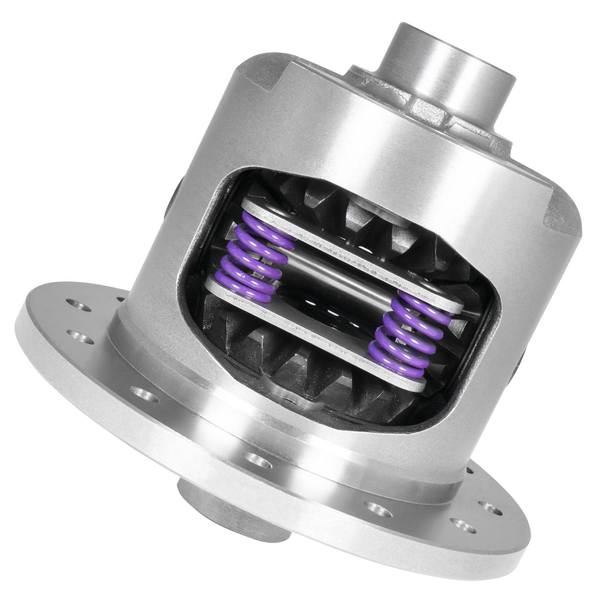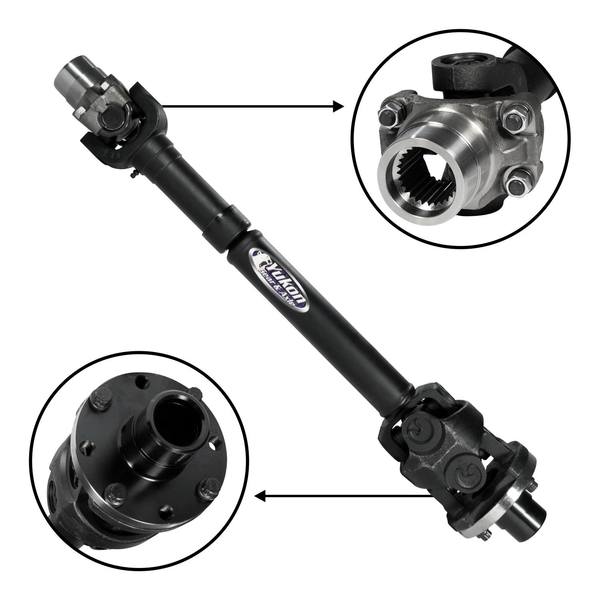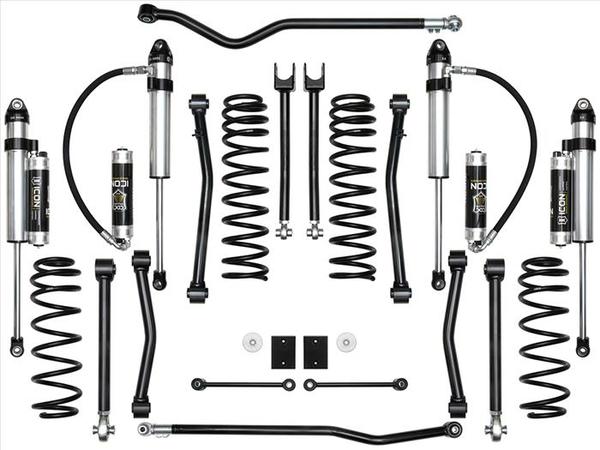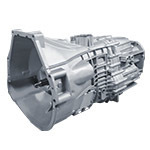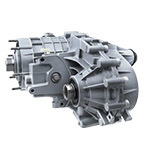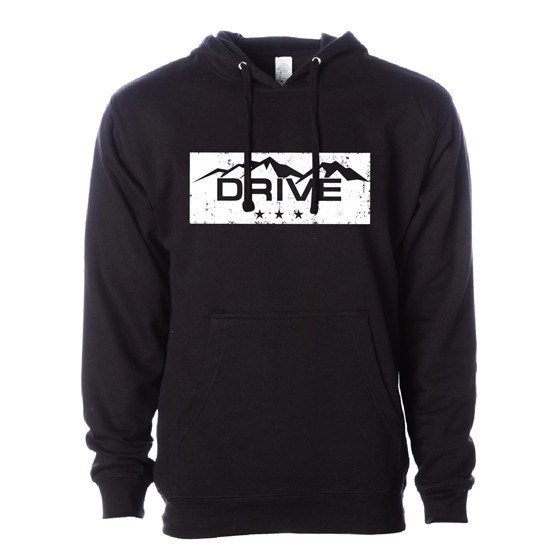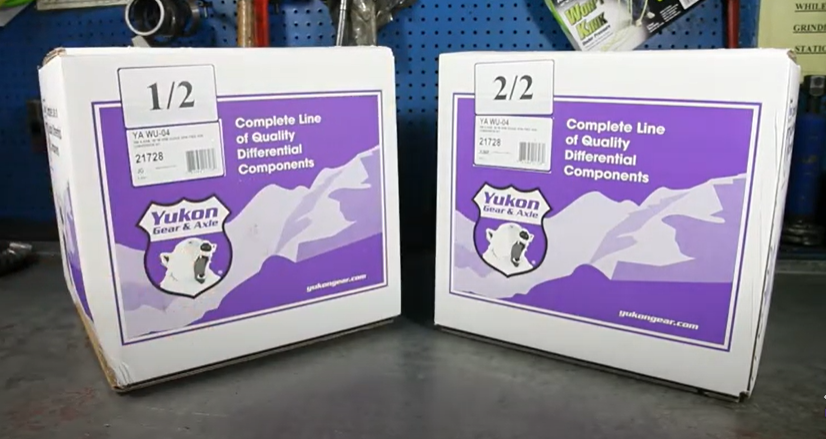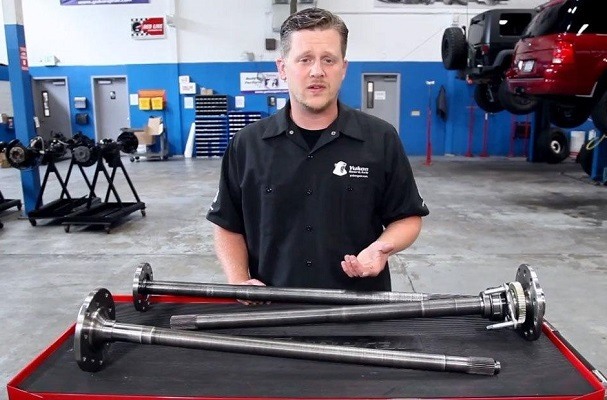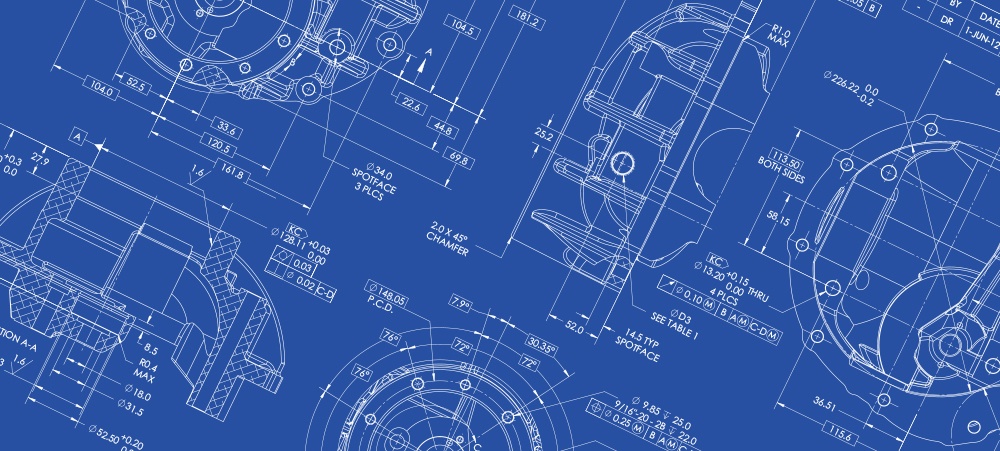Standard Carriers, Positraction & Limited Slips, Locking Differentials, Spools and Mini-Spools
As an opening note, for all situations except factory OEM electric lockers, a standard open carrier can be replaced with a limited slip or locker. Likewise, a locker or limited slip can be replaced with a standard open carrier. Limited slips and lockers can be interchanged. And of course, a spool can be installed in place of all of them. The main point is that the differential carrier unit design is independent of the housing it is being installed into (we are limiting this info to American rear wheel drive passenger cars, American trucks up to 1-1/2 ton, and Toyota Trucks). When changing differential carriers that support the ring gear, there are many rearend designs that use more than one height carrier case. In these cases, the differential carrier case must match the gear ratio and ring gear thickness. If someone tells you that the housing you have will not accept the ratio you want, they are probably wrong, but that is a whole different story.
When it comes to deciding which differential to use, there are now almost too many limited slip and locking differentials to choose from and it takes a knowledgeable sales person to help the customer choose a design that will serve their needs.
Standard/Open Carrier:
Whenever a vehicle negotiates a turn, the outside wheel must travel farther (turn faster) than the inside wheel. This is accomplished by spider gears that allow the outside wheel to turn faster (this can be either the left or the right, but must be the outside wheel) than the ring gear, while the inside wheel turns slower than the ring gear. The net sum of the speed of the two wheels is twice as fast as the ring gear. That means if the outside wheel is turning 2 rpm faster than the ring gear, the inside wheel is turning 2 rpm slower than the ring gear. This differential action is very straightforward in a standard open differential and works great for more than 95% of vehicles on the road today.
When a vehicle with an open or a standard differential encounters a loose traction surface, it directs power to the wheel with the least resistance. The resulting action is the wheel on the loose surface spins, while the opposite wheel on the better traction surface stands still or barely transfers power. The reason a standard open differential works this way is because it is designed to provide equal force to both sides. If the wheel on either side looses traction, the other side suffers as well.
If, for example, the left wheel looses traction and cannot provide a resistance force back to the differential side gear, then the right side gear cannot transfer a force to the right wheel to counteract the slipping left wheel. The main point to remember is that an open differential provides equal POWER to both sides, not equal speed.
An open differential works just fine for 95% of vehicles on the road, since most people do not spin their tires often, if at all. For those of us who like to burn rubber or go off the dry pavement, there are now too many limited slip and locking differentials to choose from.
Positractions & Limited Slips:
Posis and limited slips transmit equal torque to both wheels when driving straight. However, when one wheel spins due to loss of traction, a patch of ice, mud, too much throttle, etc., the unit automatically provides more torque to the wheel that has traction. Recommended for daily driving, works well in ice, rain, mud and snow. However, in situations where absolute lockup is needed, a limited slip is not the best choice due to the fact that limited slips do slip in some situations.
Positraction is a type of limited slip. The name “positraction” was used by General Motors for their limited slip differential and the name has been associated with limited slips for many years.
Automatic Lockers:
Lockers (mechanical locking differentials) provide 100% transfer of power to both drive wheels. This power can be lost if both wheels spin, but a locking differential will never let one wheel spin free by itself while the other one sits still (unless the unit is broken). Automatic locking differentials are engineered to keep both wheels in a constant drive mode, yet have the ability to unlock to permit a difference in wheel speed while negotiating turns.
Recommended for serious off-roaders or serious hot-rodders, they can be annoying for everyday driving. The main shortcoming of automatic lockers is the noise inherent in their design. When getting on or off the throttle, they tend to bang or clunk, or sometimes make noise while disengaging when negotiating a turn. These characteristics are due to the design and a few locker manufacturers have come up with designs that make less noise, but no one has developed a perfectly quiet automatic locker yet. One more effect of lockers that hampers every day use is that they only drive the inside wheel on a turn, which can affect vehicle handling.
When driving the inside wheel, the vehicle tends to yaw from side to side slightly when negotiating a turn under power. When turning sharply while taking off from a stop, the inside wheel will tend to spin easily. This is especially prominent when taking off on a right turn, for two reasons: the torque on the rearend housing due to the driveline torque un-weights the right wheel, and right hand turns are tighter (because we drive on the right side of the road).
On-Command Lockers:
Many people want the benefits of a locking differential, but do not want the handling characteristics or noise of an automatic locker. There are a few on-command lockers available as an OEM option. These include the 1998 and newer Toyota Tacoma and Land Cruiser. These EOM designs use an electric motor or vacuum diaphragm to engage the locker. When it is not engaged, the unit acts like a standard open differential with no ill side effects aside from poor traction. When engaged, these units’ lockup 100% and act like a spool with no differential action or difference in speed between the left and right wheels allowed.
Spools & Mini Spools:
For racing, serious off-road, or crazy hot-rodders, a spool is the ultimate traction differential. Actually, it can hardly be called a differential because it does not differentiate. Spools have several purposes. First, they lock both left and right axles solid together so that there can be no loss of power due one wheel spinning faster than the other. Second, they usually support the ring gear much better than most other differentials. Last, they can be lighter than a differential, which saves rotating mass as well as un-sprung weight that the suspension has to contain.
The main shortcoming of spools is the fact that the outside wheel has to turn faster when negotiating a turn if both wheels are to maintain traction. If the axles are locked together, one or both wheels have to slip in order for the outside wheel to travel farther than the inside wheel. This can cause the rear of the vehicle to spin out, fish-tale, or can cause a lot of noise that sounds like positraction clutch chatter as the axles twist and release. Sometimes these effects are not all that bad, and they are less severe when 35-spline or larger axles are used. For those people on a budget, there are mini-spools available for many rearend designs. A mini-spool fits inside the standard open carrier, replacing the spider gears, and locking the left and right axle shafts together just like a spool does. A mini spool drives exactly like a full spool does, but they are not as strong as a full spool and do not add any extra support to the ring gear like a spool does.
POSITRACTIONS/LIMITED SLIPS
Yukon Dura Grip (YDG)
The Yukon Dura Grip is a four spring, clutch driven limited slip with roots going back to the factory units found in 60’s & 70’s GM muscle cars. These units feature Raybestos composite clutches for long lift, while still providing strong lock-up ability for great traction. Dura Grip internal gears are cut from forged 4320 steel for added strength. Units arrive from the factory with 400lbs of preload, but can be customized with 200lb or 800lb springs for less or more aggressive handling. Dura Grips are completely rebuildable, and assembled in the USA.
Yukon Bear Trac (YBT)
The Bear Trac is the latest positraction design from Yukon Gear & Axle. The Bear Trac is a helical gear driven unit, allowing for smooth operation without sacrificing performance. Bear Tracs feature a 8620 steel case & internals for added strength and long life. Yukon Bear Tracs are designed for medium duty 2WD and 4WD applications. They work well in the front and rear, and are so smooth that there is little or no hint of resistance in the steering wheel when used in front drive steering axles. Like the Gleason Torsen, the Yukon Bear Trac does not bang or clunk, has no clutch chatter, does not wear out like clutch type positractions, does not need limited slip additive, and needs no preload or clearance adjustments.
Almost sounds too good to be true doesn’t it? The only drawbacks to the Bear Tracs are their inability to provide lockup 100% like a locking differential can. Although Gleason no longer makes the Torsen differential, the Yukon Bear Trac is a proven design that is available for many popular applications. (aftermarket) 1 yr warranty
Auburn Gear (AG)
The Auburn Gear limited slip uses a cone style clutch that wears directly against the carrier case and provides the friction force to make the unit work. This design is not rebuildable. Once the cone clutch or case wears out, the entire unit must be replaced. Even with this shortcoming, this design works well for occasional use where extra traction is needed. They have good impact strength in passenger cars and trucks up to 1 ton. They will hold up well to high horse power, but will not last long if there is a lot of tire spinning. (aftermarket) 1-year warranty
Auburn Gear PRO (AG)
These are also cone style and not rebuildable. Designed with more lockup force than regular Auburn Gear limited slips. Will provide better high performance traction than regular Auburn Gear, but still wears out under extreme off-road use and heavy wheel spin. This design tends to chatter a lot and is not recommended if the customer is looking for a smooth unit. (aftermarket) 1-year warranty
Detroit Locker (DET)
Probably the most durable design available, these are the king of traction differentials. Usually causes banging and clunking, but gives 100% lock-up whenever traction is needed. Unlocks when negotiating a turn so that the outer wheel can turn faster than the ring gear and the inside wheel, with no needed interaction from the driver. New Sof-Locker design has damping device to reduce banging and clunking, and includes a carrier case that is stronger than stock except in 2 applications, where the original factory carrier case is used. Only the 10.5″ 14 bolt truck and the Nissan V6 designs use the factory carrier case and these cases are both very strong. (aftermarket) 1-year warranty
Eaton (EAT)
Clutch type, similar to Trac-Lok in design, yet far stronger and more aggressive. These units came as an original equipment option in 65-72 12T (12 bolt GM truck), 12P (12 bolt GM passenger), 8.2″ GM pass, 63-79 Cast Iron Corvettes. The original OEM 12T case was very weak, but the new design replacement from Eaton is very strong. Four preload springs and two steel preload spring plates. Latest design uses HD nodular iron case, forged side and pinion gears, no-chatter, race-bred, carbon fiber clutches for extreme strength and longevity.
Old design, all steel clutches which are still available in 18 or 22 clutch designs for those who need more lock-up and are not bothered by clutch chatter. For even more lockup customization, there are also four levels of spring pressure available (3 from Eaton and a fourth from GM) that can be used to vary the clutch preload from 200 lbs. to 800 lbs. Originally used in mid-sixties GM muscle cars and trucks. This unit is now available for Ford applications and soon will be available for Dana Spicer, AMC, and Chrysler applications. They have a high tolerance for abuse in high horsepower vehicles. Recommended for everyday driving and severe off-road use (factory GM).
Equal-Lock
This was the first design limited slip used by Ford in both the 8″ and 9″ rearends. Except for new clutches, there are only used parts available now. This design is not aggressive and does not lock-up harder when more power is applied as most every other limited slip design does. Ford built two different Equal-lock designs. One uses four plain steel plates, three fiber lined plates, and one Belleville spring for preload. The other uses only three plain steel plates, two fiber-lined plates, and two Belleville spring plates. The design that uses two spring plates can only be converted to the single spring design with more clutches if the appropriate clutch hub is used to accommodate the higher number of clutch plates. Can be identified by five tab clutches (Ford Traction-Lock for the 8″ and 9″ use four tab clutches). (factory)
Traction-Lock (T/L)
(Also referred to as a Track-Lock, not to be mistaken with the Dana Spicer Trac-Lok) This is the second design limited slip that Ford used in both the 8-” and 9″ rearend designs. It is a fairly good design for moderate horsepower applications. This is a clutch type design that uses four plain steel clutches, four fiber lined clutches, and one plate that is steel on one side and has fiber lining on the other side. It uses a two-piece case that looks very similar to the standard open carriers, except the parting line between the two case halves is covered by the left half that “wraps around” the right half. The parting line between the two halves on a standard case is easy to see and is not covered. Traction-Locks are not very aggressive and tend to wear out fairly quickly if used heavily.
Newer design Ford rearends such as the 7.5″, 8.8″, 9.75″, 10.25″, and 10.5″ also can be ordered with Traction-Locks. These differentials use a one-piece case with two spider pinion gears, except for the heavy-duty 10.5″ rearend, which uses three spider pinion gears. The 7.5″ and 8.8″ designs have soft clutches that tend to wear-out quickly and are not aggressive even when new. The 10.25″ unit uses composite clutches that holdup fairly well, but it is not aggressive and tends to slip too much when needed off-road. Trac-Lok is a medium-duty limited slip and will hold up without breaking, but will wear out the clutches quickly under heavy-duty use. If the unit wears out it usually can be rebuilt. (factory)
Trac-Lok (T/L)
Built by Dana Spicer for use in Spicer rearends, AMC rearends, and 1998 & older 10.25″ Ford rearends. The old design built up until about 1989 was weak. The 1990 and newer design is fairly strong and even rivals the Powr-Lok for impact durability, but the clutches do not provide as much lock-up force and tend to wear out in about 50,000 miles if used in the rear. Works better in the front of vehicles because it’s not aggressive. The main selling points for this design are the fact that clutch chatter is almost non-existent, and it is very inexpensive. These two points make it a great unit for many applications and a very good value for the money. This unit makes a great front limited slip and works well for those who need a little extra traction but cannot tolerate clutch chatter. The Trac-Lok came factory installed in many models such as D28, D44, D60, AMC 20, AMC35, 10.25″ Ford. The problem with this unit is that it is not very aggressive and power transfer is minimal. Also, 1988 and earlier units tend to break fairly easily. (1piece case, 2 pinion gears, and 2 tab clutches). (factory)
Powr-Lok (P/L)
This clutch type limited slip is the strongest and most aggressive limited slip differential available from Dana Spicer. It is a clutch type unit using floating cross shafts that ride up on ramps in the case. When power is applied, the shafts ride up the ramps and load the clutches for a positive engagement. A Powr-Lok will not lock up 100%, but it is a very durable unit that will hold up fairly well with tall tires. It can be rebuilt, and can be set up smooth or aggressive by changing the clutch design or stacking configuration. Powr-Loks are easily identified by their 2-piece case. They are a very strong unit due to the 4 spider gear design that provides twice as many teeth to carry the load as a 2 spider gear unit does. However, the case bolts can stretch or loosen after severe use over time. (4 pin, 4 tab clutches) (factory)
Toyota Race Development (TRD)
This is a really good Toyota differential. They operate on the same principal as the Powr-Lok. The clutches virtually never wear out. Sometimes this unit chatters depending on the specifications requested by the importer. They are sometimes imported in small quantities by various sources and are now distributed by Auburn Gear. (aftermarket) 1-year warranty
Detroit Truetrac (TT)
Based on the worm gear principal and works like clutch type positraction. Does not wear out, not recommended for tall tires over 33″.
Detroit Truetracs are similar in design to the Gleason Torsen, only the Truetracs hold up well with reasonably tall tires. They use worm wheel gears that work on the same principle as a worm gear. When the unit is loaded, the worm wheels are forced away from each other and against the case. They develop locking torque by the light friction between the worm wheels and the case. This light friction is multiplied by the ratio of the worm wheel which depends on the size of the worm wheel relative to the size of the side gear. The manufacturer can change the amount of torque biasing or lockup by simply changing the diameter of the gears, or the pitch and spiral of the teeth. A larger difference in the size for the worm wheels and side gears (smaller worm wheels and larger side gears) will increase the lockup force. Increasing the pitch and spiral of the teeth will also increase the lockup forces. Like everything, there is a limit as to how much lockup force is reasonable. Making the unit too “aggressive” will cause tire scrub during everyday driving and will cause the unit to wear out too quickly. All of the feedback that I have received from customers indicates that the unit works very well for mud and snow, while going unnoticed during every day driving. When used in situations like rocky trails where one wheel gets off the ground, the unit will not lock up 100%. Light application of the brakes will help the differential engage more transferring power to the tire that is still on the ground. For extreme situations where the vehicle will have one wheel in the air often a locking differential provides better power transfer to the wheel on the ground.
Gleason Torsen
Worm gear type no longer made by Gleason, but a few models are build by Zexel Torsen. They are very similar to the Truetrac. (aftermarket)
Gold Trac
9″ Ford road racing and circle track. Very similar to the Truetrac, but a lot more expensive. The preload on the worm wheels can be adjusted on a Gold Trac, but they do tend to loosen up after some time. (aftermarket)
PASSIVE LOCKERS
Yukon Grizzly Locker
Yukon Gear and Axle introduced the Grizzly Locker in 2009. The unit is similar to the Detroit Locker but has new patent pending design improvements. Grizzly Lockers feature forged 8620 internals and an 8620 case to provide maximum strength and reduce common failures in other designs. The Grizzly Locker is a speed sensing design and will provide 100-percent lockup. The Grizzly Locker comes in two variations, drop-in units and carrier replacement units; the type depends on the application. GM 14-bolt and 2.5 Ton Rockwell units drop-in to the stock carriers. Carrier replacement units are available for Ford 9”, 8” and 10.25”, Toyota 4-cyl and V6, Dana Spicer 30, 44, 60, Model 35 and AAM 11.5 axles found in GM and Chrysler trucks.
Detroit Locker (DET)
Usually causes banging and clunking, but gives 100% lock-up whenever traction is needed. Unlocks when negotiating a turn so that the outer wheel can turn faster than the ring gear and the inside wheel, with no needed interaction from the driver. New Sof-Locker design has damping device to reduce banging and clunking, and includes a carrier case that is stronger than stock except in 2 applications, where the original factory carrier case is used. Only the 10.5″ 14 bolt truck and the Nissan V6 designs use the factory carrier case and these cases are both very strong. (aftermarket) 1-year warranty
Gov-lock(G/L)
Used by General Motors in 73 & newer trucks that came with an option locking / limited slip differential. It was used in 7.5″, 7.625″, 8.5″, 8.6″, 8.875″ 12 bolt truck, 9.5″, 10.5″, and now in the new 11.5″ differentials. The smaller designs are fairly weak and the 8.5″ and 12 bolt truck designs are especially weak. The 9.5″ and 10.5″ 14T units are fairly strong and will hold up well to towing and moderate abuse. The Gov-Lock is designed to act as an open differential during normal driving with no force being applied to clutches. This fact that no force is applied to the clutches keeps the clutches from chattering during normal every day driving. When either wheel slips and spins approximately 100 rpm faster than the other a governor assembly senses the difference in speed and activates a ramp system. The ramp system causes the clutches to engage and transfer power to the wheel with traction. One other feature of the Gov-Lock is that it will not engage at vehicle speed above 30 mph. This no lock-up feature keeps the vehicle more stable at higher speeds where both wheels spinning could cause an inexperienced driver to spin out or slide off of the road. This is a great design in theory and works as designed in a stock vehicle that is not abused. The problem is that most of us modify our trucks and many of us abuse them. When this unit is asked to deliver under extreme conditions it tends to self-destruct. The force generated by the ramp system that is used to lock-up the clutches works well, except that same force has to be contained by the case and the case is not always up to the job. (factory)
Spartan Locker
USA Standard Gear introduced the Spartan Locker in 2009. This automatic locker replaces the stock side and pinion gears while utilizing the factory open differential case. Spartan Lockers have a patent pending design which makes installation and removal much easier than other designs. The deep heat treating and attention to tooth design provide long life and higher strength. Most designs include a new cross pin shaft and retaining bolt or roll pin. The center pin fits in oval slots between two inner drivers. Under load the center pin forces the inner drivers outward to engage the outer axle couplers on each side of the case. This provides locked traction to both drive wheels. When turning, one driver is unloaded and the teeth can ratchet across each other creating differential action to reduce tire wear and make turning the vehicle easier. Unlike similar designs, Spartan Lockers do not use the factory thrust washers, eliminating one of the errors commonly made during installation of other designs. This is one of the most economical lockers on the market today. A wide range of applications are available.
Lock-Right (LR)(PT)
Mechanical locking mechanism that installs into the stock carrier case in place of the spider and side gears. This is a very low price unit that is fairly easy for the average vehicle owner to install if they are somewhat mechanically inclined. This unit was originally designed by Power-Trax and is still produced by them. It has also been copied by Tractech in the form of an “Easy Locker”. Works great for occasional off roaders, or for use in front differentials. This is a mechanical locking device that drives with the same results to the wheels as a Detroit Locker, but uses the standard carrier case and cross pin and does not include any parts to dampen the banging and clunking associated with a locking differential. Provides 100% lockup when traction is needed. The re-use of the original carrier case keeps the cost down but, offers no more strength than the stock carrier case. Power-Trax offers a heavy duty “Zytanium” (this is only a brand name for the material they choose not to disclose, not an actual material that can be looked up in a metallurgy book) cross-pin shaft that lasts longer than the stock cross-pin and is often necessary for differentials in which the stock cross-pin is too soft for use with the Lock-Right. Most Lock-Right designs come with enough parts to replace all of the internal side and pinion gears. A few of the Lock-Right designs use the stock side gears which are used in conjunction with the new parts. These units include the 8″ & 9″ Ford, D70’s with 2-piece case, and the Suzuki Samurai. It should be noted that the units for the Samurai are available either with parts (couplers) to replace the side gears, or as a design that uses the original side gears (without couplers). The design that uses the stock side gears actually seems to hold up better and last longer than the design that replaces the side gears. Many of the Lock-Rights built by Powertrax have been improved since the release of Tractech’s Easy Locker and the Easy Lockers have not. (aftermarket) 2 yr warranty
Heavy Duty Lock-Right (VX models) (LR) (PT)
These units drive the same as a regular Lock-Right, but include heavier springs, better materials, and the Zytanium cross shaft. In fact, the entire unit is built from the material they call Zytanium and is designed for a lot of abuse in applications such as drag racing or extreme off-road use. This unit does not have any dampening mechanism and tends to do a lot of banging and clunking when driven on the street.
Detroit EZ Locker(EZ)
Built the same as a Lock-Right with all of the same characteristics, features, benefits, and shortcomings, but only has a 1-year warranty. Fits into stock carrier case. Designed for occasional off roader. SEE Lock-Right for MORE DETAILS.(aftermarket) 1 yr warranty
Gearless Locker (GL)
The overall results of the Gearless Locker are that its operation is the same as the Detroit Locker without the extra backlash. The unit drives both tires unless the vehicle is negotiating a turn, in which case it allows the outside wheel speed to override the inside wheel speed so that the tires do not have to scuff, or be dragged around the turn. The free-wheeling side re-engages and drives again as soon as the inside tire speed catches back up with the freewheeling side when the vehicle completes a turn, or the inside tire spins and reaches the same speed as the outside tire. The only side effects are strange handling in short wheel-base vehicles while negotiating sharp turns under power, and the spinning of the inside tire while taking off from a stop sign, while turning, when the road is slippery. And the obvious question is “how does it do that?” The whole key to the operation of the Gearless Locker is the “Tunkenel-V” ramp. (is this a goofy name or what?) The force of the cross pin shaft on the Tunkenel V ramp produces a separating force between the cross pin shaft and the V ramp as the shaft attempts to ride up the ramp. This separating force on the V ramp causes a clamping force on the friction clutches, which locks the side gear to the case as the clutches engage and drives the axle, which drive the wheel. If any force causes the wheel to go faster than the ring gear that is driving it, the results of the overriding speed of the wheel will cause the force on the V ramp to decrease, and the clutches will disengage allowing the overriding wheel to free-wheel until the overriding force causing the wheel to turn faster than the ring gear is gone (when the vehicle completes the turn). This may seem complex, but read it through a few times and then give it a few days to sink in before reading it again. The idea of clutches may bring up concerns of chatter or wear. Unlike clutches in most applications, these clutches lock instantaneously and do not slip at all (which makes the unit work without the extra backlash associated with other lockers). They also release instantly when any overriding forces are created while negotiating a turn. This instant release design does not allow for any chatter whatsoever. Additionally, Trac-Tech states that in all of their extensive testing they have had no indication of clutch wear, and in fact, they provide a bottle of special additive to keep the clutch surfaces from galling due to the excellent loading of the friction clutches.
Installation of the Gearless Locker is pretty easy and straight forward. Most backyard mechanics will be able to install the unit on a long afternoon or at worst, over the weekend. Some models require removing the ring gear from the carrier, but none of them require any shimming. Like the EZ Locker from Trac-Tech, and the Lock-right from Powertrax, the Gearless Locker simply replaces the standard spider gears in a non-locking differential and works with the stock carrier case and the stock c-clips.
These will work well in both the front and the rear just like other lockers. I know that a lot of readers are reluctant to try a locker in the front. I’ve driven vehicles with front lockers and find them to be fairly well mannered. I believe that the few small changes in handling are worth the gain in traction, and using a locker will allow the unlocking of one hub for better steering during steep off-camber maneuvers. The details may seem complicated at first, but read them a few times and give the information a few days to sink in before reading it again.
Lock-Right No-Slip (PT)
This design is very similar to the regular Lock-Right, but incorporates a dampening mechanism that keeps noise and clunking to a minimum. The dampening assembly also works as a holdout ring that helps the teeth last longer and makes disengagement and freewheeling around a corner smoother and quieter.
ON COMMAND LOCKERS
Yukon Zip Locker
The Zip Locker is an air-operated locking differential. Zip Lockers are a selectable unit that offers users the option of a 100-percent fully-locked or full open operation. The advantage is, when unlocked, the unit provides a tighter turning radius and locked it provides maximum traction in all situations. This is the perfect locker for off-road use or driving on snow and ice. Zip Lockers feature a forged case and use 4320 high Nickel Chrome-Moly steel for the internal parts to provide maximum strength and durability. Each Zip locker comes will an installation kit that includes air solenoid, air line, fittings and more. All that is needed for operation is a compressor. Several air delivery options are available.
ARB Air Locker:
The ARB Air Locker is an air-operated unit, for which the locking action is controlled by the driver with a push of a button inside the cab. A 12-volt air compressor (24 volt also available) engages the unit in approximately 1 second and can be engaged at any vehicle speed. 100% drive to each wheel when the unit is locked up. While the unit is unlocked there are no handling problems, or additional wear problems. Unit can NOT be engaged while a wheel or wheels are slipping. Any good pump that supplies 95 to 115 lbs. of air pressure will work in place of the ARB pump. If the customer purchases both the ARB pump and the ARB differential, all of the parts needed are included, even the wiring.
Popular Resources:
 AMC
AMC
 Chrysler
Chrysler
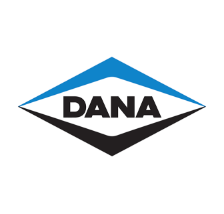 Dana
Dana
 Ford
Ford
 GM
GM
 Isuzu
Isuzu
 Nissan
Nissan
 Suzuki
Suzuki
 Toyota
Toyota
